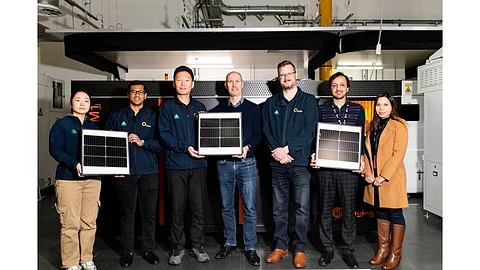

Tindo & UNSW collaborate: Australia’s sole solar module manufacturer, Tindo Solar, has entered into a collaboration with the University of New South Wales (UNSW) to explore TOPCon solar cell technology. Short for Tunnel Oxide Passivated Contact, TOPCon was initially developed in the 1980s by Professor Martin Green at UNSW. Now, the team wants to prove that their TOPCon cells will perform reliably in real conditions under heat, humidity, UV exposure, and harsh weather conditions in many parts of Australia. TOPCon cells can achieve 27% efficiency in lab settings. The team will together develop a high-performing and highly durable Australian TOPCon solar cell, they said.
AEMO’s latest scorecard: The latest Connections Scorecard of the Australian Energy Market Operator (AEMO) shows that within 12 months to June 2025, a total of 29 renewable energy and storage projects with a combined 4.4 GW capacity achieved full output in the National Electricity Market (NEM). This level is a record, doubling from last year’s total. Within June 2025 alone, 10 projects representing a combined 1.5 GW capacity reached full output. “At the end of June, there were 260 projects (totalling 53 GW) in the connections process, a 39% increase in capacity compared to the same time last year. Of this, 7 GW is already built and commissioning to full output,” shared AEMO’s Executive General Manager System Design, Merryn York. She also said that a lot of projects are hybrid, mostly solar paired with storage, and standalone batteries with grid-forming inverters.
Rules for dormant Filipino RE projects: The Philippines Department of Energy (DOE) is mulling streamlined rules for ‘dormant’ renewable energy projects, including those with delayed timelines of over 3 years. Speaking to reporters recently, Energy Assistant Secretary Mylene Capongcol said that idle developments may be placed under the Open and Competitive Selection Process (OCSP) under which new contracts will be awarded. According to the Manila Bulletin, solar energy projects are expected to complete the pre-development phase within 2 years. Failing the declaration of completion (DOC), the DOE releases a show-cause notice. If there is no justification, then the project contract is terminated in order to make use of available space and increase renewable energy capacity.
Centralines picks Lodestone: New Zealand-based solar developer Lodestone Energy has been selected by local electricity distributor Centralines to develop the Ongaonga Solar Farm in the country. It is expected to generate 52 GWh annually for use in Central Hawke’s Bay. At peak generation, it will power the entire district and export excess to the national grid, connecting directly into Centralines’ network. Centralines will use the NZD 8 million funding from the Kiwi government’s Regional Infrastructure Fund (RIF) to develop the project.
Ingeteam part of Marywale hybrid project: Ingeteam is supplying 32 power stations, including a total of 61 central PV inverters and 488 units of 430 kW DC-DC storage converters, for the Maryvale Solar and Storage Project in Australia. Owned by Gentari, the project in New South Wales (NSW) is the 1st DC-coupled solar-plus-storage project being developed in eastern Australia, says Ingeteam. The Maryvale project will comprise 243 MW of solar PV with a 172 MW/2.4 MWh co-located battery energy storage system (BESS). It is expected to come online in Q2 2027.
Pilecom for 106 MW project: Australia-based Pilecom has commenced work on the 106 MW Lancaster Solar Farm in collaboration with European Energy Australia and Nextracker. It will install 23,274 piles, 1,683 single-axis Horizon trackers, and 170,000 solar modules on site. The project is located about 9 km east of Kyabram in Victoria. It is expected to generate 216 GWh/year after it is grid-connected in 2026. European Energy acquired the project from Sweden’s OX2.
